Forestry Visor Cap 1938 Pattern (Higher Ranked Operational Officials version)
CATEGORY: Version
SKU: 75.GOR.01.01.002.001
Estimated market value:
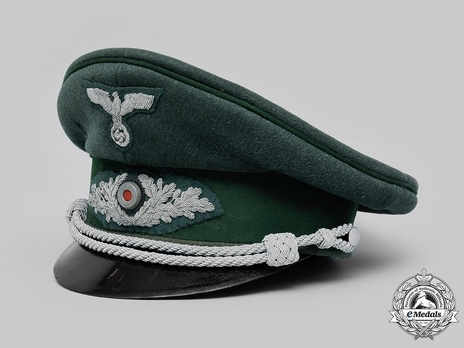
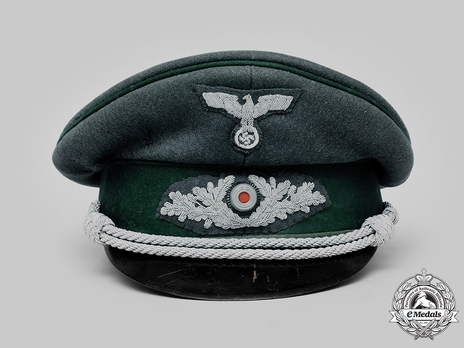
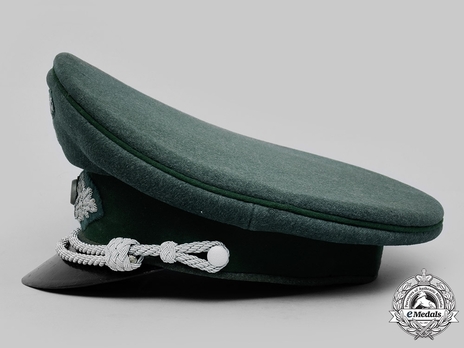
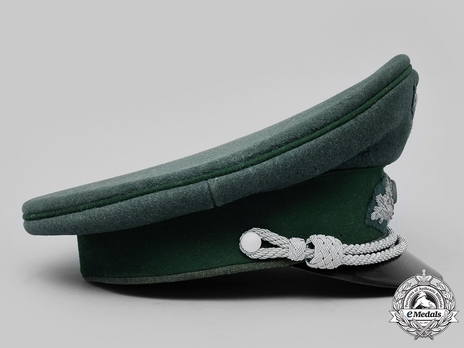
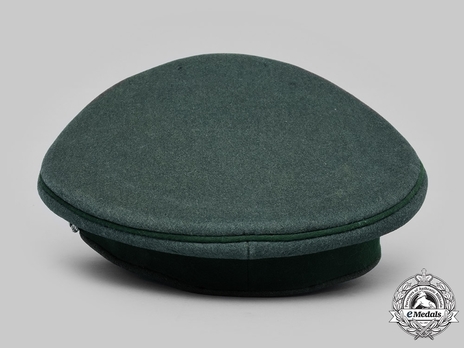
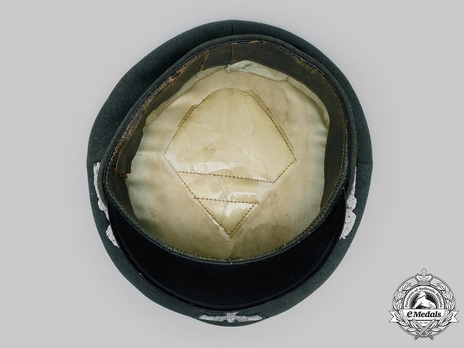
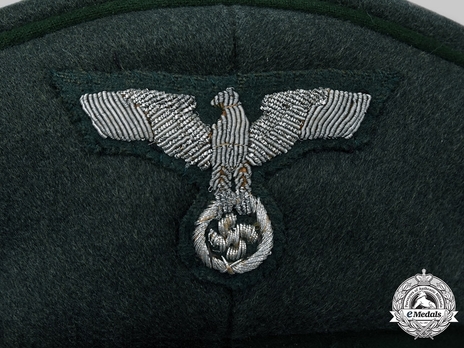
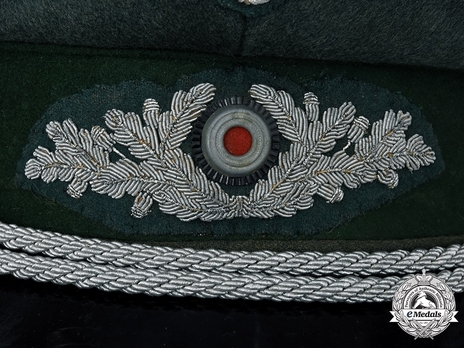
Estimated market value:
A well-preserved Reich Forestry Service (Reichsforstdienst) officer’s visor cap, constructed of field-grey wool with a forest-green cap band. Bands of forest-green piping surround both the crown, as well as the top and bottom of the cap band. Stitched into the peak of the cap is an insignia consisting of a padded forest-green wool base bearing a hand-embroidered silver aluminum wire German national eagle clutching a mobile swastika. The insignia measures 68 mm (w) x 42 mm (h). Stitched into the center of the cap band is a wreath and cockade, on a padded forest-green wool backer, constructed of hand-embroidered silver aluminum wire and zink, respectively. The wreath measures 120 mm (w) x 40 mm (h) overall. The cap is flanked on each side by a pebbled magnetic metal button securing in place a decorative chinstrap, constructed of multiple rows of silver aluminum wire, which rests upon the visor. The latter is constructed of black lacquered vulcanfibre and is set securely into the structure of the cap. The interior features a green leather sweatband, measuring 40 mm in width, and a light green rayon liner. A partially-intact transparent moisture guard is stitched into the crown, underneath which the remnants of an “EREL” maker’s mark are visible. An additional Erel mark is stamped onto the sweatband. Issues consisting with age and use are visible to the cap, and including mothing and material fatigue of the wool, material fatigue and cracking of the sweatband, soiling of the interior liner, and degradation of the moisture guard. The cap is in an overall very fine condition.
Like every organisation during the Third Reich, forestry was placed under the control of the NSDAP. The Reichsforstamt (National Forestry Office) was created in 1934 to replace the regional forestry departments that had existed prior to this date. The goals of the Reichsforstamt were to extract economic value in the form of timber from the forests for the German industry, as well as preserve nature and natural monuments for the people as a part of German culture.
A sub-department for professional hunters employed by the government was created. Hunting matters had formerly been a part of the Ministry for Food and Agriculture, but were now placed under the influence of the Reichsforstamt.
Private forestry matters were placed under the care of the Reichsnährstand (National Nutritional Estate) in 1941.
The Reichsforstamt was headed by Luftwaffe leader Hermann Göring as Reichsforstmeister (minister of forestry).
The Reichsbund Deutsche Jägerschaft (National Society of German Hunters) was founded in 1934 as a statutory corporation for non-professional hunters. All existing hunting societies were disbanded and memberships transferred to the Deutsche Jägerschaft. Membership was mandatory for everyone with a hunting license.
Hermann Göring led the organisation as Reichsjägermeister (minister of hunting).
The Reichsforstschutz or Forstschutzkommando (Forestry Protection Service), in 1943 renamed to Forstschutzkorps (Forestry Protection Corps), was a paramilitary force instituted in February of 1940 in the General Government (occupied Poland). Made up of German forestry officials and ethnic Germans from Poland, the Forstschutz was tasked with regular forestry duties, as well as patrolling and protecting woodlands to keep them from being used by the Polish resistance. In 1942, Forstschutz personnel was also stationed in the Eastern European occupied territories where their work was heavily focused on anti-partisan operations.
Very little is known about the Forstschutz organisation today, and all items related to it are exceedingly rare.
The first regulation for Forestry visor caps was introduced in 1934. The cap is grey-green with a darker forest-green cap band and piping of the same colour on the crown and above and below the cap band. The visor was initially made of leather, however, towards the late 1930s it was replaced by vulcan fiber.
On the cap crown, an eagle emblem was worn in combination with a cockade on the cap band. The eagle was silver or gold-coloured, depending on the wearer’s rank, and either embroidered or made of metal.
The earlier 1920’s visor caps had featured leather chin straps for all ranks. Beginning in 1934, the visor cap was used exclusively for formal occasions. As a result, chin straps were introduced in different designs, depending on the wearer’s rank. Forestry members were grouped as either Betriebsbeamte (operation officials) or Verwaltungsbeamte (administration officials). Among the operation officials, the lower ranks (up to Förster) kept wearing the leather chin strap, while the higher ranks wore green chin cords flecked with gold. Administration officials (Forstassessor and up) wore gold-coloured chin cords flecked with green. The highest ranks wore gold-coloured chin cords.
This system was changed in 1938 when ranks from Förster up to Landforstmeister began wearing silver-coloured chin cords. No change was made for the lower ranks and the highest ranks who still wore black leather straps and gold-coloured cords, respectively.
A variation of the regular visor cap was the so-called “Feldmütze alter Art” (old style field cap, also known as a “crusher cap”). This cap was produced without stiffeners and was therefore soft and foldable. This cap didn’t feature chin straps or cords.
Forestry personnel in the service of the Heer (Army) or Luftwaffe (Air Force) wore the same pieces of headgear as regular forestry personnel, but with the insignia of their respective organisations.

Comments
Sign in to comment and reply.


Scroll Top